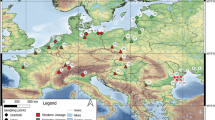Abstract
If gene regulatory processes form the basis of phenotypic plasticity that evidences itself as discrete adaptive norms (sensu developmental conversion), it seems evident that the forms capable of such adaptations would possess a correspondingly richer genome than those lacking such adaptations. We examine evidence for the existence of genetic triads which are comprised of one form with wide niches due to phenotypic plasticity and two forms, each which is genetically fixed and exhibits a phenotype at one of the extremes of the plastic form. The invasion of organisms into new environments may occur by acquisition of discrete adaptive norms (DAN), which enable a transition between the old and new environments. The horohalinicum (=critical salinity) is defined as a salinity zone which always corresponds to 5–8 ppm and divides freshwater and marine faunas and floras, as well as many other physico-chemical characteristics. The current paper explores the existence of discrete adaptive norms and genetic triads with respect to salinity in some euryhaline crustaceans, particularly the arctic copepods, and discusses how such adaptations might inform us about species boundaries that affect the taxonomic status of these forms.
Similar content being viewed by others
References
Barsukov, V. V., 1981. The brief review of subfamily Sebastinae system. Voprosy Ikhtiologii 21: 3–27 (in Russian).
Berger, V. Y. & A. D. Kharazova, 1997. Mechanisms of salinity adaptations in marine molluscs. Hydrobiologia 355: 115–126.
Borutzkiy, E. V., L. A. Stepanova & M. S. Kos, 1991. Keys of fresh water Calanoida. Nauka, Sanct-Petersburg: 503 pp (in Russian).
Bradshaw, A. D., 1965. Evolutionary significance of phenotypic plasticity in plants. Advances in Genetics 13: 115–155.
Brodskiy, K. A., N. V. Vyshkvartzeva, M.S. Kos & E. L. Markhaseva, 1983. Copepoda Calanoida of the seas of the USSR and adjacent waters. Nauka, Leningrad: 357 pp (in Russian).
Bruton, M. N. (ed.), 1989. Alternative Life History Styles of Animals. Kluwer Academic Publishers, Dordrecht, The Netherlands: 616 pp.
Chislenko, L. L., 1972. Zooplankton of the Dikson Inlet (Kara Sea). Study of the marine fauna (Leningrad) 12: 228–238 (in Russian).
Dudnik, Y. V., 1977. Antibiotics as an instrument of investigation. In Environment and Developing Organism. Nauka, Moscow: 336–362 (in Russian).
Gale, E. F., E. Cundliffe, P. E. Reynolds, M. H. Richmond & M. J. Waring, 1972. The Molecular Basis of Antibiotic Action. Wiley-Interscience Publication, London-New York-Sydney-Toronto.
Gause, G. F., 1947. Problems of evolution. Trans. Conn. Acad. Arts Sci. 37: 17–68.
Khlebovich, V. V., 1965. To physiology of euryhalinity: critical salinity of environment and inner medium. In Voprosy gidrobiologii, 1, Nauka, Moscow: 440–441 (in Russian).
Khlebovich, V. V., 1969. Aspects of animal evolution related to critical salinity and internal state. Mar. Biol. 2: 338–345.
Khlebovich, V. V., 1974. Critical Salinity of Biological Processes. Nauka, Leningrad: 235 pp (in Russian).
Khlebovich, V. V., 1981 Acclimation in Animal Organisms. Nauka, Leningrad: 135 pp (in Russian).
Khlebovich, V. V., 1990. Some physico-chemical and biological phenomena in the salinity gradient. Limnologica (Berlin) 20: 5–8.
Khlebovich, V. V. (in press). Adaptive norms and genetic triads. Proc. Inst. Hist. Sciences and Technol, St. Petersburg (in Russian).
Khmelova, N. N., V. F. Kulesh., A. V. Alekhnovich & Y. G. Guiguinyak, 1997. Ecology of freshwater prawns. Belaruskaya navuka, Minsk: 254 pp (in Russian).
Kinne, O. 1971. Salinity-Invertebrates. In Kinne, O. (ed.), Marine Ecology 2, Part 2. Wiley-Interscience, London: 821–995.
Labas, Y. A. & V. V. Khlebovich, 1976. 'Phenotypical window' of genome and progressive evolution. In Salinity Adaptations of the Aquatic Animals. Zoological Institute Acad. Sci. USSR, Leningrad: 4–25 (in Russian).
Mednikov, B. M., 1987. Problem of species formation and adaptive norm. J. Gen. Biol. (Moscow) 48: 15–26 (in Russian).
Mikhailova, N. P., Y. A. Labas, T. R. Soidla & V. V. Khlebovich, 1976. Aminazine resistant mutants characterized by specific expression in various conditions of energy metabolism of yeasts cells. In Salinity Adaptations of the Aquatic Animals. Zoological Institute Acad. Sci. USSR, Lenungrad: 232–236 (in Russian).
Neyfakh, A. A.& M. Y. Timofeeva, 1977. Molecular biology of development processes. Nauka, Moscow: 310 pp (in Russian).
Pigliucci, M., 1996. How organisms respond to environmental changes: from phenotypes to molecules (and vice versa). Trends. Ecol. Evol. 11: 168–173.
Pirozhnikov, P. L., 1958. On the area and ecology of copepod Senecella calanoides Juday. Zool.Zhurn. (Moscow) 37: 625–629 (in Russian).
Pora, E. A. & S. Carausu, 1939. Sur la resistance de l'amphipode Pontogammarus maeoticus de la mer Noire aux variations de salinite du milieu ambiant. Ann. sci. univ. Jassy 25: 1–14.
Schlichting, C. D & M. Pigliucci, 1998. Phenotypic evolution: a reaction norm perspective. Sinauer Associates, Inc: 387 pp.
Schmalhausen, I. I., 1940. Variability and change of adaptive norms in the evolution. J. Gen. Biol. 1: 509–528 (in Russian).
Schmalhausen, I. I., 1986. Factors of Evolution: the Theory of Stabilizing Selection. University of Chicago Press, Chicago.
Serebrovskyi, A. S., 1973. Some problems of organic evolution. Nauka, Moscow: 168 pp (in Russian).
Schaffer, H. B. & M. L. McKnight, 1996. The polytypic species revisited: genetic differentiation and molecular phylogenetics of the tiger salamander Ambystoma tigrinium (amphibia: Caudata) complex. Evolution 50: 417–433.
Shaposhnikova, G. K., 1940. Nutrition of Coregonus autumnalis (Pallas) in Ob Bay. Proc. Inst. Polar Agricul. (Moscow-Leningrad) 10: 625–629 (in Russian).
Smith-Gill, 1983. Developmental plasticity: developmental conversion versus phenotypic modulation. Am. Zool. 23: 47–55.
Vyshkvartzeva, N. V., 1994. Senecella sibirica n.sp. and the position of the genus Senecella in Calanoida classification. Hydrobiologia 292/293: 113–121.
Author information
Authors and Affiliations
Rights and permissions
About this article
Cite this article
Khlebovich, V.V., Abramova, E.N. Some problems of crustacean taxonomy related to the phenomenon of Horohalinicum. Hydrobiologia 417, 109–113 (2000). https://doi.org/10.1023/A:1003863623267
Issue Date:
DOI: https://doi.org/10.1023/A:1003863623267




